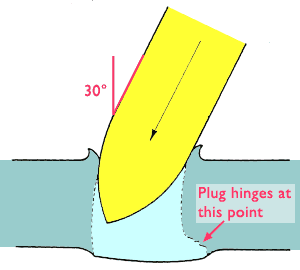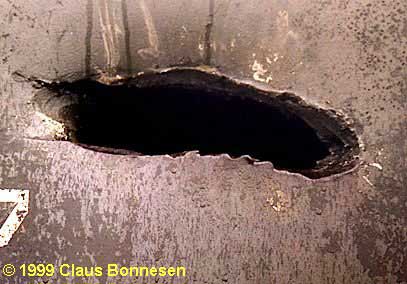
Logo from Scott Cunningham.

Logo from Scott Cunningham.
 t small angles of attack, little change occurs in the mode of plate failure. The hole in the plate usually has a direction intermediate between the direction of attack and the normal, and the other main charateristics of discing, plugging, back petalling, etc., remains the same. At angles around 20° to 30°, however, some differences become apparent.1
t small angles of attack, little change occurs in the mode of plate failure. The hole in the plate usually has a direction intermediate between the direction of attack and the normal, and the other main charateristics of discing, plugging, back petalling, etc., remains the same. At angles around 20° to 30°, however, some differences become apparent.1
The plate thickness which can be defeated by a given projectile decreases with increase in angle of attack. As a result, failure by plugging tends to be more common than back petalling at angles of attack of 30° or more, in plates free from serious laminar weakness, since at these angles the attack is, in practice, likely to be made against relatively thin plates and such plates tend to plug. The plug shears out over surfaces which are roughly perpendicular to the plate face, but which show a curvature due to the tendency of the plug to have a hinging action about the end furthest from the projectile’s head.1

The formation of a plug in a 30° attack, showing the position of the hinging action. Tensile fracture frequently occurs at the hinge point. Diagram from 1.
Moreover, when plugging occurs at these angles it is usually found that the plug is roughly elliptical in section, with a minor axis equal to the projectile calibre and with a major axis slightly greater and lying in the plane of attack.1

Although hit at an angle well in excess of 30°, this shows the elliptical cross-section typical of a plug formed by an oblique attack. From On Armour.
The fact that the plug forms by shearing in a direction roughly perpendicular to the plate face leads to the expectation that only the kinetic energy associated with the normal component of velocity of the projectile would be effective. This does, in fact, appear to be the case, since a penetration formula of the form:1
 . . . . . . (4)
. . . . . . (4)
where mp = mass of projectile (kg);
V = velocity of the projectile at impact (m/s);
![]() = angle of attack;
= angle of attack;
t = thickness of armour perforated (mm);
d = diameter of projectile (mm); and
C, n = constants.
gives the best agreement with observed results for angles from 0° to 30°.1
 Attack at Oblique Angles Beyond 30°
Attack at Oblique Angles Beyond 30°
Do you like this web site? Please rate it between one and ten, with ten being the best:
Ratings are submitted to: The Wargames and Military History Search Engine.
Copyright © 2000 David Michael Honner. E-mail: GvA@wargamer.org.